Born Free (1966)
Directed by: James Hill
Written by: Bill Travers, Joy Adamson, Lester Cole
Starring: Bill Travers, Geoffrey Keen, Peter Lukoye, Virginia McKenna
UK
AVAILABLE ON DUAL FORMAT BLU-RAY AND DVD: NOW, from EUREKA ENTERTAINMENT
RUNNING TIME: 95 min
REVIEWED BY: Dr Lenera, Official HCF Critic
Married couple George and Joy Adamson have long lived in northern Kenya for George’s work as the senior game warden of the region. One of George’s primary responsibilities is to deal with dangerous animals that may be chronically threatening to humans, livestock and/or crops. It is in this vein that George and his staff end up killing a man eating lion and its lioness, resulting in their three young female cubs being orphaned. Although difficult to begin, George and Joy are able to wean and take care of the three cubs, who they adopt as pets. But soon, they know they have to provide a more suitable environment for the cubs….
John Barry, who wrote the Oscar-winning score to Born Free and the tune to the song of the same title that even a lot of young people seem to know, didn’t think much of the film, saying that the director James Hill had misled him as to its nature, which he thought was more of a sentimental Disney animal movie. Well, with all due respects to the great man who remains probably my top film music composer and has written some of my favourite music in the world, I think he was wrong. Yes, there are some cute and funny moments involving its animals, but they never go over into anthropomorphism and certainly don’t dominate the film, a poignant sadness and a considerable depth soon beginning to take over. Born Free doesn’t shy away from the savagery of its main animals and indeed nature itself: rather, it presents a world where violence and danger are a natural and even sometimes an essential part of the world – take for example the way the male hero has to sometimes shoot lions as part of his job to keep humans safe and to maintain the right balance. I’d loved Born Free as a kid, but never gotten around to watching it since despite having owned the soundtrack CD for many years. Now I’ve viewed it again, I think it’s one of the greatest of all animal-orientated movies and a film which I believe all kids should be treated to by their parents.
It’s a rather romanticised adaptation of a diary-like novel by the real Joy Adamson and follows it fairly closely. Her husband George Adamson served as chief technical advisor on the film and discusses his involvement in his first autobiography, Bwana Game, known in the US as A Lifetime with Lions. They “interviewed” over 3000 lions and after using some circus ones failed to work out, they used hand trained and even some wild ones, something which when you watch some of the scenes in the film is mindboggling in these times when CGI is mostly used for potentially dangerous sequences. The original director was Tom McGowan but he was replaced by James Hill when McGowan failed to get on with many of the cast members. Shot mostly in Kenya, the film kickstarted a general interest in animal welfare and was a life-changing experience for stars Virginia McKenna and Bill Travers who were married in real life: they became animal rights activists and co-created the Born Free Foundation. The lion used were freed upon completion of filming, though this was under protest by the studio who wanted to sell the lions to zoos to get some money back from filming. A 1969 documentary called The Lions Are Free saw Travers revisit these lions and the real George Adamson. Born Free didn’t fare too well with critics [who often seem to be resistant to animal films] but was one of 1965’s biggest hits. ‘Presenter’ Carl Foreman didn’t like the Matt Monro-sung theme song, and removed it from the original British release of the film. After it reached the US charts in a cover version by pianist Roger Williams, Foreman saw its Oscar chances and reinstated the song. 1972 saw a sequel called Living Free based on the second of the three book follow-ups, and there was also a TV series in 1974 and a TV movie in 1996.
It’s quite brave of the film to begin with showing lions at their least sympathetic: as dangerous man-eaters. A native woman is by a river when a lion leaps at her – and we cut to the river flowing by and see first the woman’s torn clothes and then a load of blood in the water. It may make a few parents in today’s over-sensitive times concerned, but don’t worry, there aren’t any other human kill scenes though there are some later moments of peril, and the scene is essential to the film, because we are immediately made aware of how dangerous these creatures can be, and we have this awareness at the back of our minds when the cutesy stuff begins, which effectively tempers it. Anyway, we then meet Joy as she begins to narrate, and yes there is quite a bit of narration in this movie, and it’s a little annoying in a few moments, but generally it moves the story forward quite nicely. I don’t know if the real-life couple upon whom they’re based are similar, and their life probably wouldn’t have been so idyllic, but Joy and George are a great couple to spend time with and we quickly get an understanding of why they lead the lives that they do. The couple are childless, and Joy’s attachment to one of the three baby lionesses in the film is partly because she’s a partial substitute for a human baby, but I love the way that neither of this is actually stated in the film. A modern version would probably throw in some intense discussion about all this, just so that every single viewer gets the points rammed down their throats, but films back in the 1960’s were allowed to be more subtle.
After shooting the male lion who killed the woman, George is forced to kill the mother too because she attacks them. Considering this, it’s perhaps small wonder that they adopt their three cubs. If you dislike animal films then you probably aren’t reading this review anyway, but if you do [I plead guilty, I enjoy – for example – Free Willy] then you will fall in love with these three adorable animals, in particular the runt Elsa, and even when she knocks down clothes lines and rips up cushions. And the Adamson’s also own a – well, it’s something called a rock hyrax which looks like a rodent but is actually more closely related to elephants – who has a taste for alcohol. But we are constantly made aware of what these cubs will eventually become. Kendall, a character who might very well have been turned into a villain if the film were more recent, asks when the cubs will “get around to eating people”. The Adamson’s reluctantly agree to have the cubs shipped off to a zoo in Rotterdam – but George surprises his wife by leaving Elsa behind with them. The bond between Joy and Elsa remains, but after Elsa “playing” with some elephants creates some damage and another lion nearby is causing some havoc, even Joy realises that Elsa is too big and dangerous to remain with her. She refuses to let a zoo take her, so opts to do something that’s never been done before: to train a domesticated lion so it can go back into the wild. Will she succeed? Even if you haven’t seen the film before then you’ll probably know the answer, but it’s still pretty engaging. Joy almost seems mad at times when her methods put Elsa in great danger, while the last few scenes may very well bring on the tears if you’re the type who gets sentimental about animals, or – perhaps more universally – can relate to having to let go of something you love.
Technically Born Free may seem occasionally a little sloppy to modern eyes. This lifelong Tarzan fan is well used to seeing animal stock footage that doesn’t quite match the main action, and integrating such shots was probably the only way they could do some of the scenes, but it may jar to some, as may some quick but noticeably speeded up shots. There are also two ludicrously bright sequences set supposedly at night but obviously shot during the day. The film is still an impressive achievement overall – the difficulty in staging some moments must have been huge. And I can’t imagine anybody – not just animal lovers – faulting the two main messages: that death and danger are part of the balance of nature, and that any living creature born free has the right to live free. As somebody who has grown to detest the idea of zoos in recent years unless it’s for conservational purposes and endangered species, I cannot commend more highly the way the film presents the latter point, without seeming to preach or ram it down your throat – yet making you totally aware of it.
Real-life couples don’t always exude much chemistry onscreen, but Travers and McKenna manage to have quite a bit, though it’s McKenna who has the lion’s [sorry] share of the dramatic acting oppurtunities, and she totally comes up trumps every time. In some scenes she almost broke my heart as much as she did in the superb Carve Her Name With Pride. Barry’s score, which utilises some Africa percussion instruments to suggest a sense of locale without hitting you over the head with it, is just tremendous, not so much underlying as increasing the story’s many moods. The main theme never outstays its welcome as it given several variations and guises, some of the dramatic moments could have come from the same year’s Thunderball while there’s a playfulness in places that Barry seemed to lose later. It’s an essential ingredient in this charming, warm yet also highly intelligent film that I’d recommend to pretty much anyone unless you really do dislike animals or animal-related pictures. It actually seems to have quite a bit to say about life in general.
Rating: 









Sourced from the Region ‘A’ Twilight Time disc, Born Free’s opening credits look slightly rough, but things improve significantly after that, though some of the ‘real life’ nature photography can’t help but look overly grainy. In general though this is a fine presentation – colours aren’t always that bright, but then the film seems to attempting a grittier, more subdued look than normal for films set in Africa around the time. Clarity and depth of field are very strong. The audio commentary is the usual very relaxed and cordial Twilight Time fare. Stalwarts Nick Redman and Julie Kirgo are joined by film music expert John Burlingame who a few years ago wrote a fantastic book on James Bond film music. There’s plenty of background information provided, though even lovers of the score [like myself] may tire just a little of them saying how wonderful it is. Be warned though: you will learn some rather upsetting truths which sometimes contradict the impression left by the film.
As usual with Eureka, they’ve added to the Twilight Time version. The three featurettes, coming to around half an hour overall, only sometimes refer to the film, but will be of interest if you found it affecting. Spirit Of Elsa is introduced by Travers himself and looks at an attempt to carry out a lion census in Meru National Park, along the way removing traps that give animals a slow, painful death. Elsa The Lionness shows the Born Free Foundation rescuing some poorly treated animals from a circus in Sardinia and trying to acclimatise a lioness to a future life in the wild just like Elsa in the film. McKenna shows up briefly. It’s not actually about the animal in the film though despite what some sources detailing the special features list. And the very short promotional featurette tells us what the foundation is all about and the importance of its work.
SPECIAL FEATURES
*Stunning High-Definition Presentation
*Uncompressed monaural soundtrack on the Blu-ray
*Isolated score track
*Audio Commentary with Film Historians Jon Burlingame, Julie Kirgo, and Nick Redman
*Spirit of Elsa – a featurette on the Born Free Foundations work in Kenya
*Elsa the Lioness – a short featurette about Elsa, a lioness undergoing rehabilitation.
*A promotional featurette, generously provided by the Born Free Foundation.
*Original Theatrical Trailers

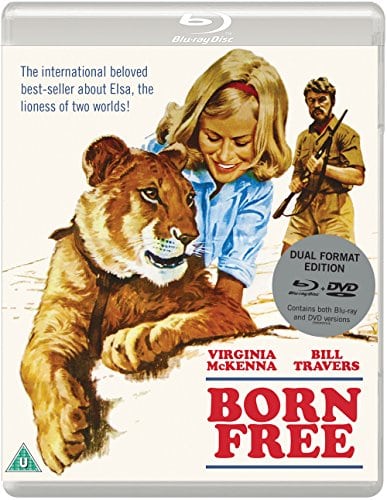
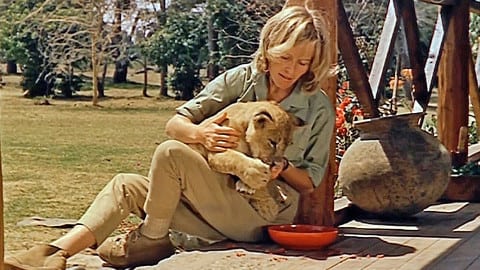
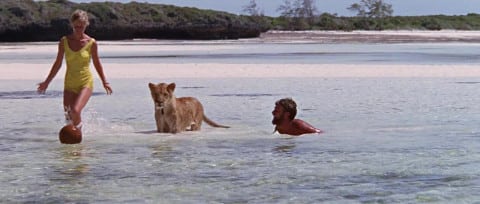

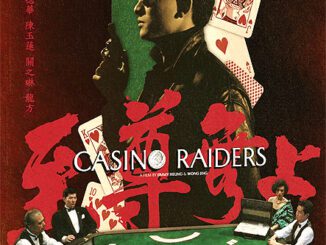
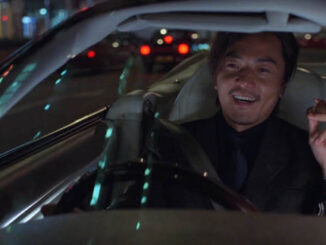
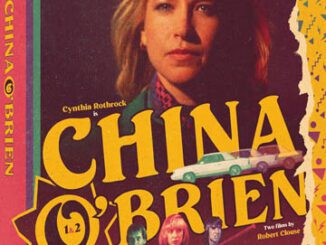
I’ve seen the film a few times, and I’m puzzled why you state in your review that “one of the cubs dies”. Two of them are sent to the zoo and Elsa is kept (after being initially slated to join her sisters in captivity). The rock hyrax, on the other hand, does die, so…
I watched it a second time the other day and I have no idea why I wrote that. The review was written back in the day when I was churning out four reviews a week and consequently made the odd mistake. Thanks for reading though.